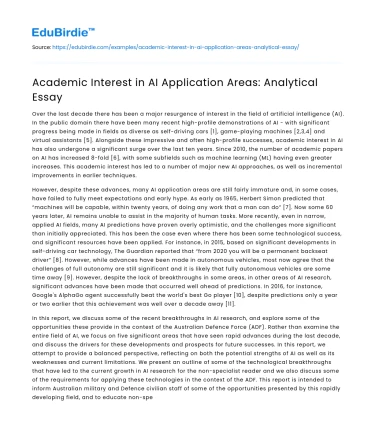Over the last decade there has been a major resurgence of interest in the field of artificial intelligence (AI). In the public domain there have been many recent high-profile demonstrations of AI - with significant progress being made in fields as diverse as self-driving cars [1], game-playing machines [2,3,4] and virtual assistants [5]. Alongside these impressive and often high-profile successes, academic interest in AI has also undergone a significant surge over the last ten years. Since 2010, the number of academic papers on AI has increased 8-fold [6], with some subfields such as machine learning (ML) having even greater increases. This academic interest has led to a number of major new AI approaches, as well as incremental improvements in earlier techniques.
However, despite these advances, many AI application areas are still fairly immature and, in some cases, have failed to fully meet expectations and early hype. As early as 1965, Herbert Simon predicted that “machines will be capable, within twenty years, of doing any work that a man can do” [7]. Now some 60 years later, AI remains unable to assist in the majority of human tasks. More recently, even in narrow, applied AI fields, many AI predictions have proven overly optimistic, and the challenges more significant than initially appreciated. This has been the case even where there has been some technological success, and significant resources have been applied. For instance, in 2015, based on significant developments in self-driving car technology, The Guardian reported that “from 2020 you will be a permanent backseat driver” [8]. However, while advances have been made in autonomous vehicles, most now agree that the challenges of full autonomy are still significant and it is likely that fully autonomous vehicles are some time away [9]. However, despite the lack of breakthroughs in some areas, in other areas of AI research, significant advances have been made that occurred well ahead of predictions. In 2016, for instance, Google's AlphaGo agent successfully beat the world's best Go player [10], despite predictions only a year or two earlier that this achievement was well over a decade away [11].
Save your time!
We can take care of your essay
- Proper editing and formatting
- Free revision, title page, and bibliography
- Flexible prices and money-back guarantee
In this report, we discuss some of the recent breakthroughs in AI research, and explore some of the opportunities these provide in the context of the Australian Defence Force (ADF). Rather than examine the entire field of AI, we focus on five significant areas that have seen rapid advances during the last decade, and discuss the drivers for these developments and prospects for future successes. In this report, we attempt to provide a balanced perspective, reflecting on both the potential strengths of AI as well as its weaknesses and current limitations. We present an outline of some of the technological breakthroughs that have led to the current growth in AI research for the non-specialist reader and we also discuss some of the requirements for applying these technologies in the context of the ADF. This report is intended to inform Australian military and Defence civilian staff of some of the opportunities presented by this rapidly developing field, and to educate non-specialists on some of the limitations of current techniques.
We begin with a high-level summary of the history of artificial intelligence research, in order to provide some context to the current wave of AI development. We discuss the drivers for the current growth in AI interest and, in particular, provide an explanation of the field of deep learning and the reason for its exponential growth over the last decade. We then discuss some emerging application areas that were chosen as they represent technologies that have advanced significantly over the last decade and, as such, provide new opportunities for applications in the military context. Finally, we discuss some enabling capabilities that need to be addressed by the ADF if they are to successfully embrace these emerging technologies.






 Stuck on your essay?
Stuck on your essay?

